About an hour southeast of Seoul, there is a town/city called Icheon (이천). It and its immediate neighboring city Yeoju (여주) are both known for their premium quality rice—so much so, it had long been the choice of the Joseon Kings. Still to this day, their rice is coveted by many and there are rows of restaurants in those two cities that specialize in serving what’s called baek-ban (백반), a set meal that features the traditionally cooked local rice and a whole bunch of banchans (반찬, side dishes).
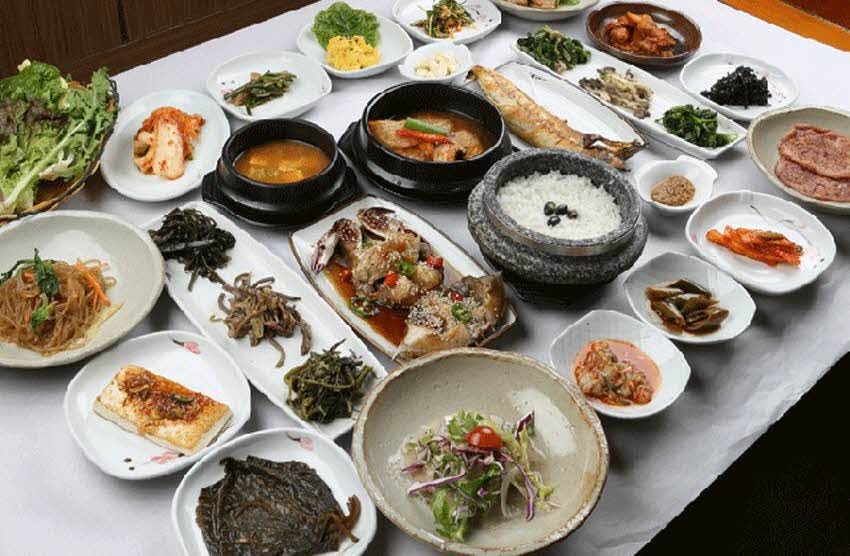
There is something else that Icheon is famous for. It is known as the city of 도자기 (dojagi). But before anything else, let’s agree to use the word 도자기 instead of “ceramics” or “pottery,” at least for this post. It’s like calling sushi “raw fish on vinegared rice.” Something gets lost.
Rice and dojagi… As you will see, the regional environment under which the two became famous in Icheon aren’t unrelated.
Let’s define the word 도자기 first. I’ll mathematize the Korean word with English equivalents for easier visualization.
도자기 (dojagi, “ceramics”) = 도기 (dogi, “earthenware”) + 자기 (jagi, “porcelain”)
The English word “ceramics” of course has a much broader meaning, but for the purpose of this post, we’ll pretend that ceramics is an umbrella term for 도기 and 자기.
- 도기 (Earthenware)
made out of clay
found everywhere, abundant, best quality found 6~9 feet below old rice paddies
Icheon is known for its nutrient-rich fields and crystal clear water (both absolute requisites for rice growing and earthenware pottery making)
may or may not be coated with ceramic glaze called yoo-yak (유약) that gives it a sheen or matte look
cooked in *relatively* low temperature, between 800~1000 degrees Celsius (1470~1830 in Fahrenheit)
darker in color
more for everyday use (historically speaking)
rougher, uneven surface (compared to jagi)
- 자기 (Porcelain)
made out of a very specific kind of clay known as the “Kaolin” clay, named after a region in China where the material is found in abundance and first written about by a European observer
called Goh-ryeong toh (고령토, “toh” is mud, dirt, or clay). Goh-ryeong is Koreanized pronunciation of “Kaolin”
mostly found in southeastern part of South Korea, including my hometown of Geochang (거창, I’ll keep mentioning it until everyone knows it, ha!)
must be coated with ceramic glaze called yoo-yak (유약)
cooked in higher temperature between 1100~1400 degrees Celsius (2000~2550 in Fahrenheit)
lighter in color
more for decorative use and expensive
flawless surface
These are the main differences and the ones you find behind secured glass casings at museums are invariably the 자기 (porcelain) kind. But for everyday lives of Korean people for time immemorial, 도기 played far more important role, especially in the traditional Korean sauce/condiment (like soy sauce and gochujang) making.
I would be remiss if I didn’t talk about ong-gi (옹기) at this point. 옹기 or 장독 (same things) are a type of 도기 in that they are made of clay and have dark brown color. I wrote about the importance of 장독 in my previous post about the Korean sauces/condiments. In it, I’ve written that these containers breathe in and out tiny amounts of air, helping the contents age, ferment, and develop deep flavor. While I knew that to be true, I didn’t understand how that worked, until I started doing my googling for this post.
Since the raw material (clay), unlike the Kaolin clay, contains tiny bits of sand grains, the surface creates microscopic air bubbles around them even after they’re treated with lye water before cooking in the kiln. Hence the air passage.
Getting back to the city of Icheon… I’ve never been to this part of the country nor do I know anything of significance about this place, except for what I’ve seen on TV a few times. But it is one of those places that I would love to visit in the future.
At any rate, there is this dojagi-themed handcraft/shopping district called Yes Park in Icheon. The sign in blue says “藝’s Park,” and is conventionally (and conveniently) called Yes Park because that Chinese character is read as “yeh (예)” in Korean and it means “art” in its broadest definition.
This walking video of the Yes Park on YouTube is a wonderful introduction to the village and it is deeply therapeutic. I hope you indulge yourself for at least a few minutes.
The main street is lined with spacious (book) cafes that serve coffee, traditional tea and desserts and handcraft workshops where you can learn how to make dojagi or just go shopping.
I’ll show you a few pictures from some of these shops that are in the Icheon Ceramic Art Village. If you want to see more, please click this link.
I’m sure you’ve all seen how the clay is painstakingly molded by hand, so I’ll skip that part to save space for the kiln and the people who’ve mastered the art of cooking them.
It is said that the correct temperature and keeping it even inside the kiln ultimately decides the quality of the finished product. Temperature not high enough? The surface won’t be as smooth and hard, and it will leave cracks. Uneven temperature throughout? Unexpected colors will appear.
The traditional kiln for dojagi called 가마 (gama) looks something like this.
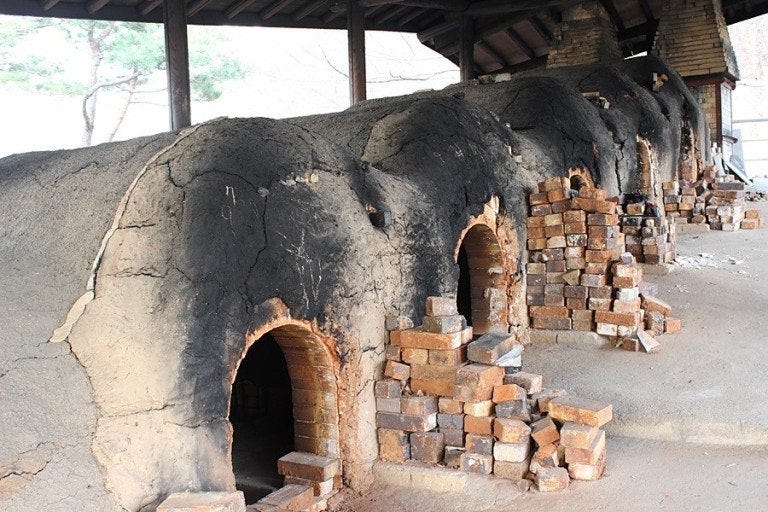
Although we can’t quite see it from this picture, the chambers are on a slight incline such as shown in the following diagram.
Each chamber is bigger than what you’d imagine, with some as big as a small house. An adult person can easily go inside and arrange the raw dojagi.
And when everything is finally ready…
Fire is lit. See the mountain of firewood in the back? It must be from the pine tree (because they leave no ash—is that true?) that’s been completely de-barked and dried for 3 to 4 years! They also have to be cut roughly the same size in thickness and length—about the size of a child’s arm, they say.
This final process is said to be such an unpredictable work because there’s no telling how the fire inside the kiln behaves. What’s more, to get the kiln up to the desired temperature, depending on the type of dojagi, it can take as long as 4 full days of feeding the fire nonstop. And you cannot leave, not even for a few minutes (about 4 people take turns).
But in the meanwhile, these fire masters do enjoy something that no layman can. Cook 삼겹살 (pork belly) on a grill in the fire. For those of you who’ve had sam-gyup-sal barbecue at Korean restaurants, you will appreciate the fact that these thick slices of pork belly will cook to perfection in 5 seconds! (I’ve seen this on TV and it literally took 5 seconds.)
It is said that all fire masters in the old days used to go blind eventually because they have to keep their eyes on the flame constantly and the excessive exposure to the heat radiation badly damages their cornea and pupil.
After the final temperature is reached, it still needs to cook for another 24 hours. Even after the fire has been put out, you can’t enter those kiln chambers—they will be still too hot. How long does it take for the chambers to cool down so that people can go in and take the dojagi out? 20 days.
But in recent days, gas kilns have been mostly used—it’s easier to maintain a certain temperature, takes one day to heat up and one day to cool down. There are a few who stick to the old traditional ways, however, in Icheon and Hapcheon (county next to Geochang my hometown).
Long, arduous, and painful, but super gratifying labor of love this is, for those few who are dedicated to the art. (Let’s not complain how expensive these can be…)






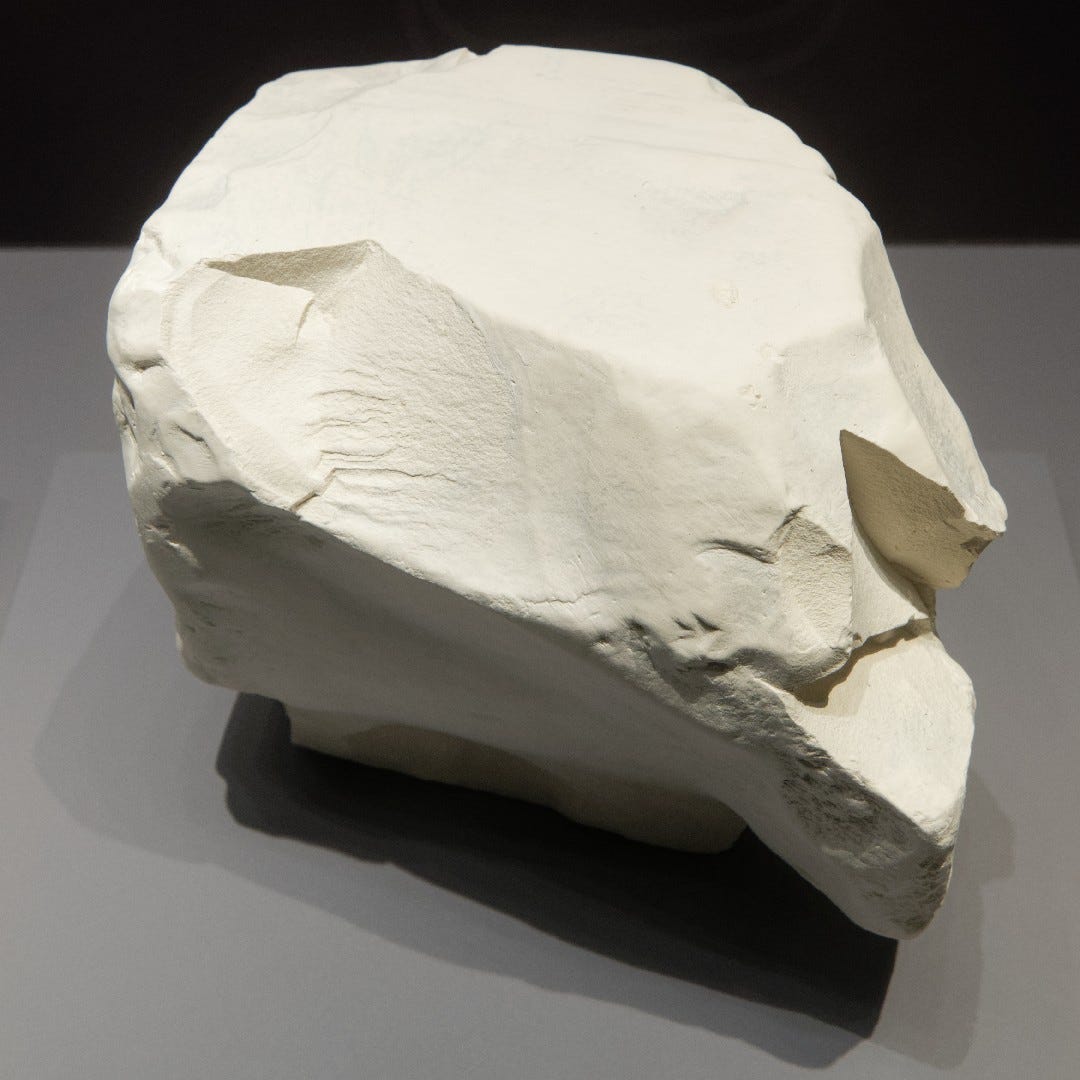









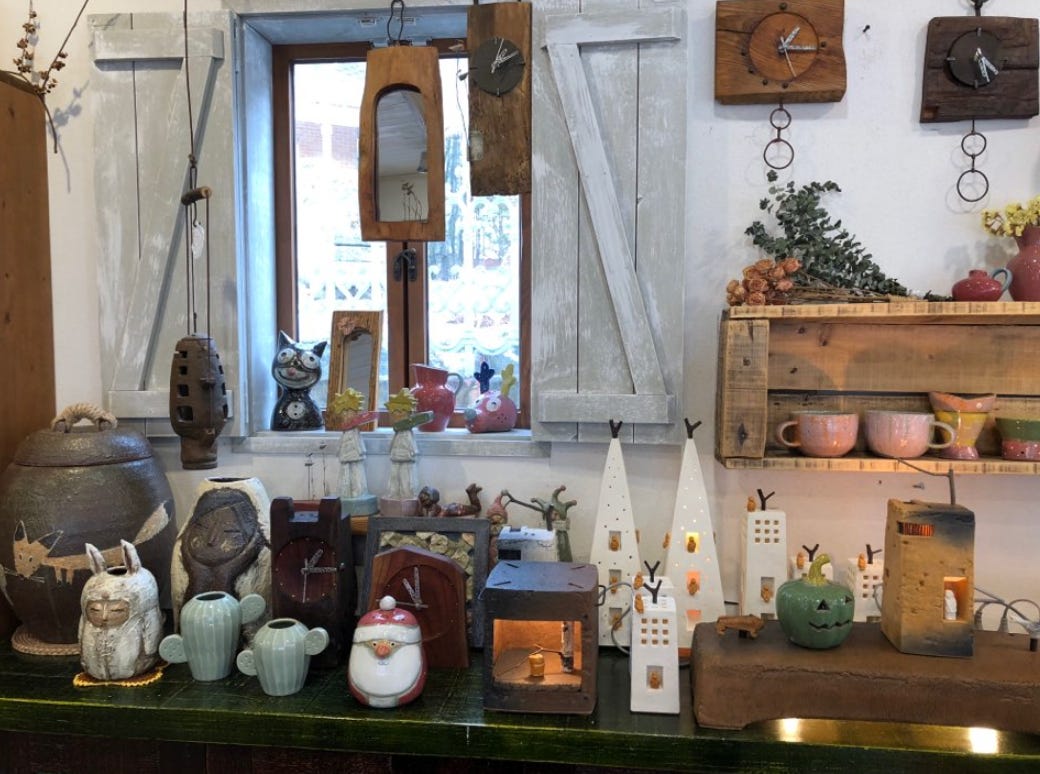
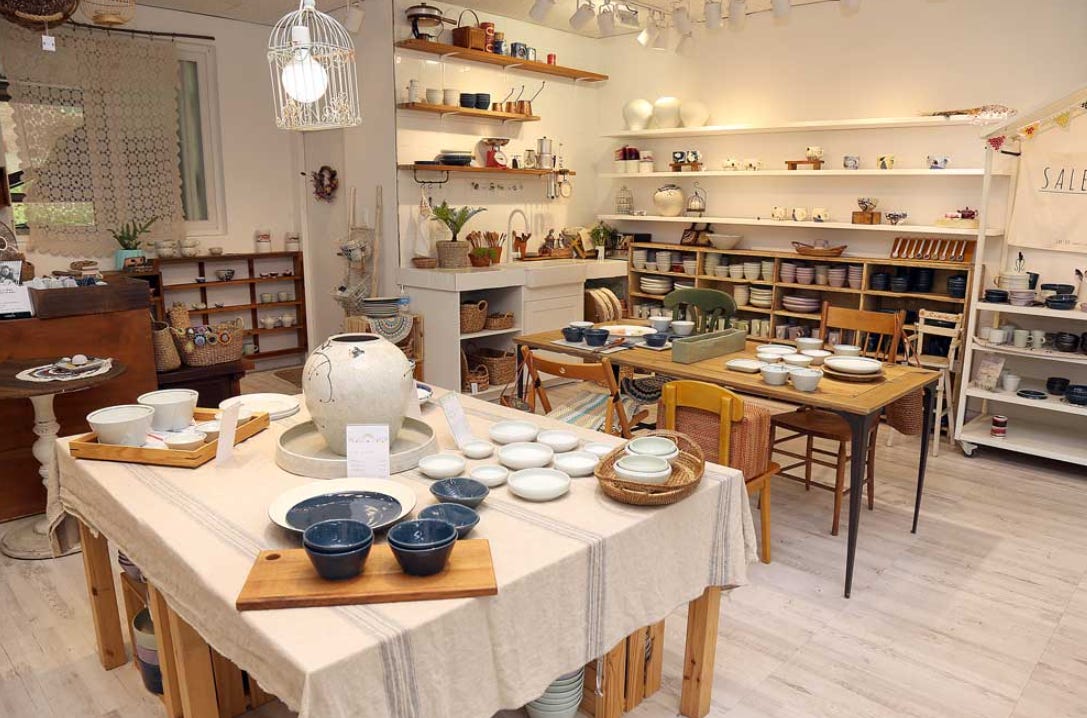
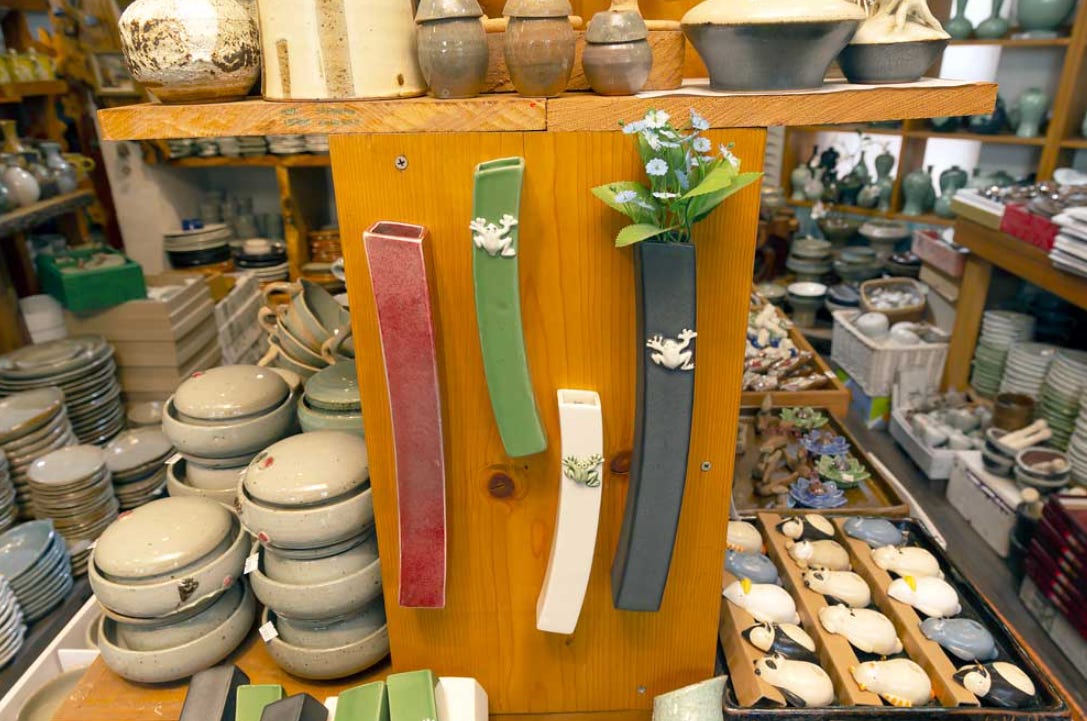



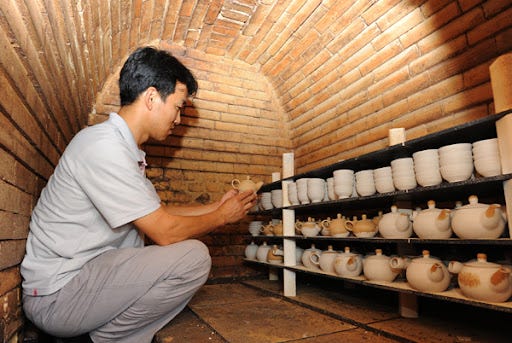

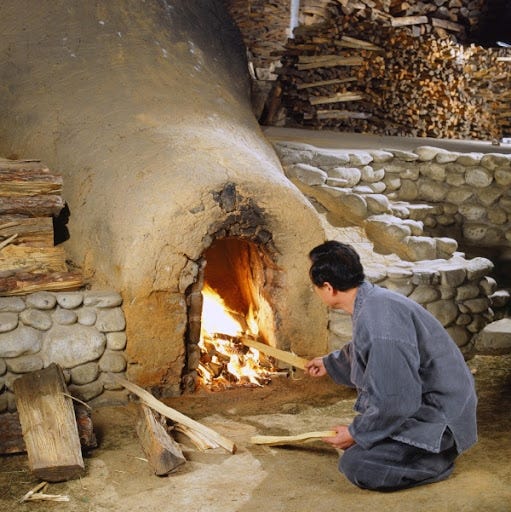


I especially appreciate the stories of crafts people whose families have passed down the tradtion of 도자기 from one generaion to the next, and I find photos of ong-gi (옹기) in family yards amazing. We live near Haystack Mountain School of Crafts in Deer Isle, Maine. Because of that proximity, my husband, brother-in-law and friends have done a bit of pottery, often times at the school. Hand-
thrown pottery is full of its creator's energy, vision and care. There are many aspects about life in rural Maine that remind me of your essays about life in South Korea (just not Seoul). If I ever master my Korean language learning, I would consider visiting places like Icheon and Hapcheon. Since my background is in dance, I would also visit a place like Hahoe Folk Village known for its masked folk dance dramas. South Korea's cultural history has much to respect and admire.